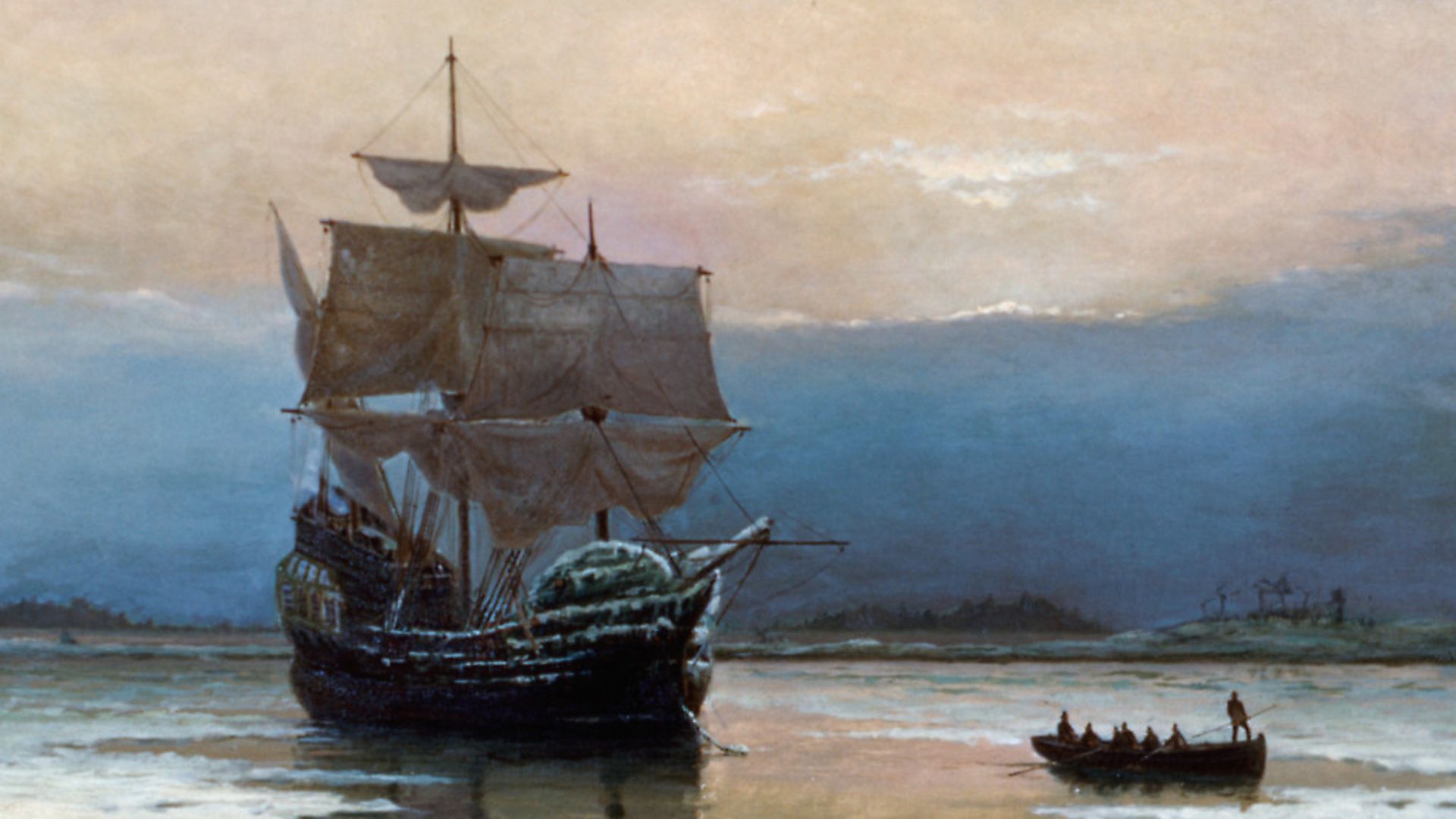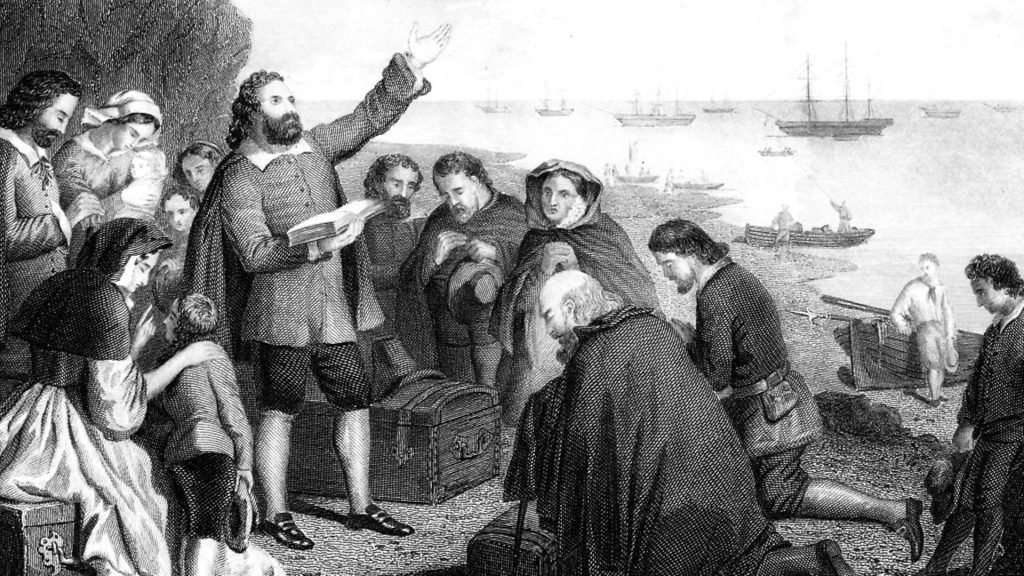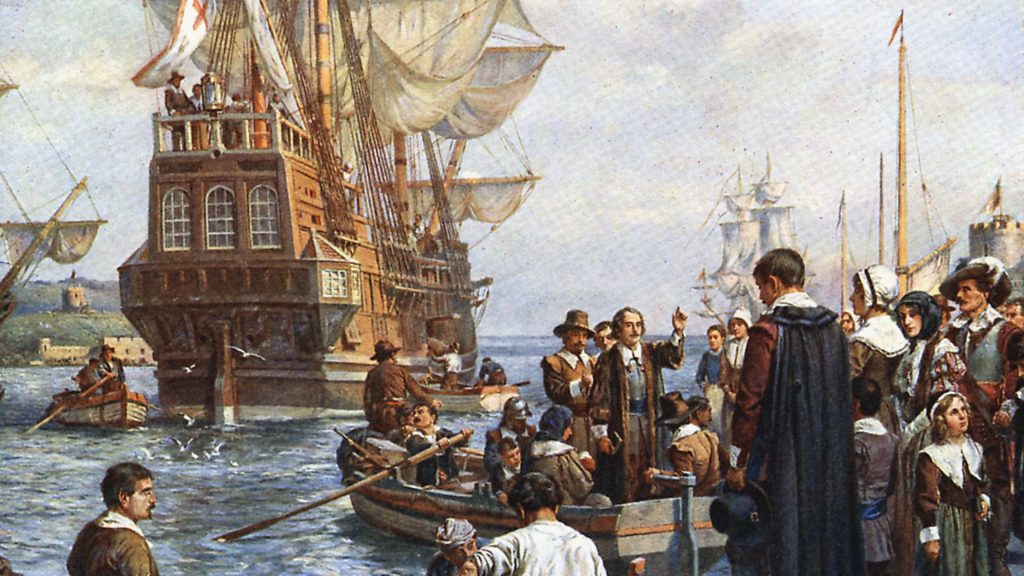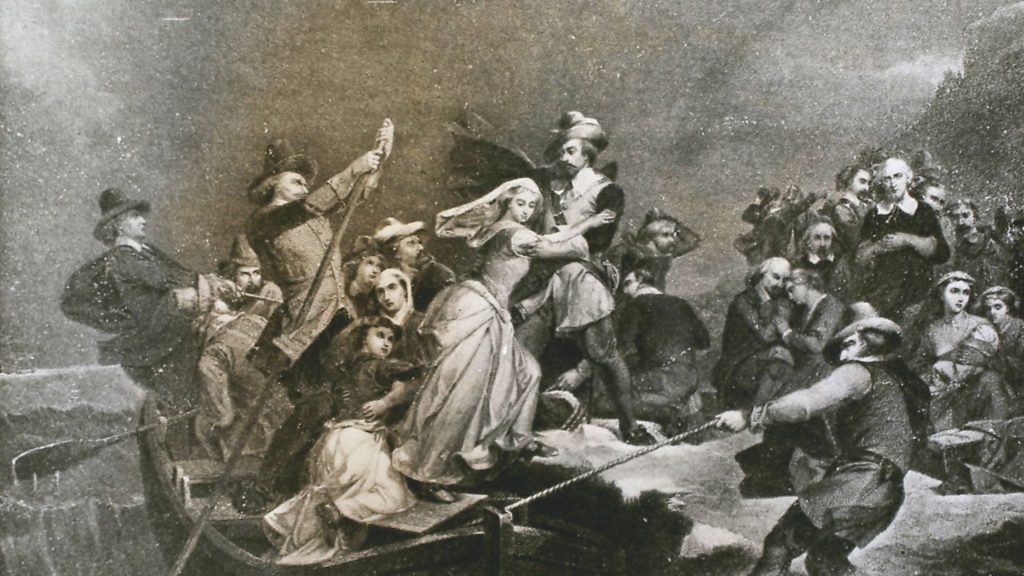
Four hundred years on from their voyage aboard the Mayflower, Richard Holledge asks whether we should consider the Pilgrim Father heroes or villains of history.

The story of the Mayflower has been mythologised and misunderstood for generations.
The passengers are reverently referred to as ‘Pilgrim Fathers’ despite there being as many women and children as men on the ship; and lumped together as ‘pilgrims’ even though it was a minority who were driven by fierce religious convictions – the rest were adventurers eager to profit from the fish and beaver trade in New England.
Myths and mistakes are easily corrected but as the publicity for this year’s 400th anniversary of the voyage was rolled out by the umbrella group, Mayflower 400, an intriguing narrative developed – that of the voyagers as colonialists.
It began In November, last year when the Financial Times derided Thanksgiving – which is traditionally attributed to the ‘rejoicing’ of the settlers at the first harvest – as America’s ‘favourite jamboree’ and a ‘ritual template for a virtuous America (not withstanding the campaign, well under way, of ethnically cleansing its native inhabitants)’.

Another US magazine joined in by describing how the Native Americans of the Wampanoag tribe had joined the feast and that a ‘good time was had by all, before things quietly took their natural course which was to end in land grab and destruction’.
The thinking gained traction when the UK’s National Education Union (NEU) chimed in with a motion at its conference in April expressing its concern that ‘the colonial narrative, which is being promoted by Mayflower 400… risks undermining… awareness in education circles about the need to greatly improve teaching about colonialism in the UK’.
The global reaction to the killing of George Floyd in Minnesota has only intensified scrutiny of the Mayflower and, for many, strengthened this narrative of its passengers as plunderers and exploiters, to be held responsible for all that came after them. In the Daily Mirror last month, columnist Susie Boniface drew a direct line between the vessel’s voyage and Floyd’s death: ‘The US was founded, 400 years ago this year by the Mayflower Pilgrims, on the idea of supremacy. Specifically, white, Protestant supremacy. What happened in Minneapolis last week, when George Floyd was murdered… started at Plymouth Rock in 1620 when 35 radical fundamentalists decided it was theirs.’
It’s a striking, provocative claim of the sort that might move activists to tear down statues of the settlers.

There are only a handful of plaques and memorials in Britain, but several in Plymouth, Massachusetts – where the pilgrims settled – not least the National Monument to the Forefathers. It has, thus far, been left untouched – perhaps unsurprising since it stands at 81ft and is thought to be the world’s largest solid granite statue. Another nearby monument, the Pilgrim Maiden, has not been so lucky. It was splashed with red paint by a vandal in February. It may be that these symbols and others are unlikely beneficiaries of the coronavirus, which has led to the cancellation of this summer’s 400th anniversary celebrations in the US, reducing not only the risk of infections, but also of a cultural flashpoint.
Notwithstanding the pause in proceedings, the ‘colonial narrative’, far being ignored as the NEU lamented, had been playing a central part in the anniversary publicity. Under the heading Mayflower 400: Legend and Legacy, The Box – a museum in Plymouth, Devon, built to coincide with the celebrations – announced it would open with a ‘major exhibition looking at the controversial history of British colonisation’. A Wampanoag ceramicist was to make a cooking pot based on a traditional design and there were plans for a ‘fully decolonised art and events programme’ presented by 29 Native American artists from New Mexico.
Manifestly, north America did fall victim to colonisation and its ethnic peoples almost wiped out, though most of its vast territory was appropriated in the 18th and 19th centuries by north Americans themselves. And there can be no argument that the Native American tribes absolutely deserve a place in the anniversary limelight.
After all, the Wampanoag could well have destroyed the new arrivals who were so enfeebled by starvation and scurvy that half died within four months of landing, leaving only six or seven strong enough to carry arms.
Instead, they came in peace and showed them how survive in that alien landscape, grow corn, catch fish and ensure the harvest by laying herrings head to head as a fertiliser.
So yes, they should be part of the commemorations. Paula Peters, however, a Wampanoag who is helping advise the British with their plans, wants even greater emphasis on her ancestors’ role in the story.
‘So often the story of the Mayflower is just about the boat,’ she says. ‘The Mayflower lands and the pilgrims are depicted as founders, not takers.’
But, in a way, 2020 is precisely about the boat. Most of 1620 was spent trying to find suitable ships and negotiating the terms by which pilgrims and adventurers could administer the new settlement.
After much dither and delay the pilgrims set sail from Holland, where they lived in exile after fleeing English persecution, on the Speedwell. If it hadn’t ‘leaked like a sieve’ and been forced to abandon the voyage we would be celebrating Speedwell 400. Instead many of them piled on board the Mayflower, which had been hired separately by the adventurers, and sailed from Plymouth, Devon.
From July – when the ship left Holland – to the following January – once they had all finally moved ashore into new shelters – all the players – pilgrims, adventurers, wives, children and servants were incarcerated on the vessel. No boat, no Plymouth Plantation, nothing to celebrate – or castigate.
So, founders or takers?
In the run up to Thanksgiving last year, the New Yorker magazine claimed that far from being ‘good hearted settlers from pious, civilised England… the pilgrims were, in fact, a warrior tribe’.
Their motives contradict that unlikely claim. One leading pilgrim, William Bradford – who would serve as governor of the colony for around 30 years – wrote that they had decided to flee to Virginia, as the English colony all along the eastern seaboard was then known (they would never get there – they ended up landing further north than planned), because they were disheartened by the hardship of life in Holland and appalled at the licentiousness of the youth. Above all, they yearned to preach and live by the gospel as they saw it.
It is hard to find a less convincing example of a ‘warrior tribe’ than the bedraggled group of 102 souls whose ship dropped anchor off Cape Cod in November 1620. In fact, they were so short of weapons that Bradford lamented: ‘Nor every man a sword to his side, lacking many muskets, much armour etc… we trust to the good providence of God.’
For some, such as the anti-slavery campaigning group, the Mayflower Mavericks, this represents as ‘an armed invasion’. If so, it sounds like a very poorly-armed one. But these critics suggest that there is evidence of warlike intent in the one contemporary image of the pilgrims, The Departure of the Pilgrim Fathers at Delfshaven, painted by Adam Willaerts which depicts surprisingly heavily armed men and even women carrying pikes.
Furthermore the recruitment of a military chief, one Myles Standish, a veteran of English campaigns in the Netherlands, is offered as additional proof of militant aspirations. But is this a warrior tribe or a bunch of apprehensive folk preparing to fight off what they described as the ‘wild lions and savages’ which lay in wait for them?
As indeed they were. Within a few weeks of landing the Native Americans came out of hiding and rained arrows down on the intruders only for them fire back, wounding one and sending the rest scurrying for cover.
Now, during this time, the accusation of being ‘takers’ has some resonance. As they searched for the ideal place to build their new home they stole corn which the local tribe had stored under mats. To be fair, they were carrying beads to trade with the people and they were starving but, yes, takers, though hardly the behaviour of an occupying force.
Once they had chosen Plymouth, Massachusetts, for the settlement, the 50 or so survivors of the first deadly winter were alarmed when one March day in 1621, out of the forest strode an Indian chief with an armed retinue. Fear turned to astonishment and then to relief when he greeted them: ‘Hello English.’ One of the few phrases he had learnt from previous explorers.
Within days chief Massasoit, a name revered in Wampanoag folklore, and the settlers had signed a treaty which guaranteed that neither side would attack the other and that any transgression would be punished. That mutual defence pact saved the settlers and suited the Wampanoag, who themselves had been weakened by plagues spread by previous European explorers.
In judging Plymouth as a colonial power it’s worth noting that its most aggressive actions were against the fellow English settlers who not only undermined their vision of a well-ordered, God-fearing society but, just as worryingly to them, were rivals in the fur trade.
Under the captaincy of Standish their homes were destroyed and the inhabitants driven away and it was the notoriously short-tempered Standish who was at the centre of a particularly egregious incident.
He claimed he had been insulted by a chief – not from the Wampanoag – who also threatened to ‘ruinate’ the settlement and lured him to a meeting where he stabbed him to death before beheading him. He was a ‘bloody and bold villain’, deemed Bradford and ordered that his head be impaled on a pole as ‘a warning and terror to all of that disposition’. (Standish has the grandest statue of all, built on his farm on Captain’s Hill 200ft above sea level).
It was a shameful incident but not one that impinged on the peaceable relationship between settlers and Wampanoag, who did not resist as the English encroached on their traditional farmland.
Rather, they accepted payment from the likes of Bradford, who bought a township for £16 and nine shillings (today around £2,000) while another settler paid six coats, half a dozen pairs of small breeches, 10 hoes, 10 hatchets and two brass kettles.
This apparent ease between the two communities was to be disturbed when, in 1630, 11 ships carrying 700 refugees under the leadership of Puritan John Winthrop sailed to New England to escape persecution at the hands of Charles I.
By 1635, the population of Boston had exploded to 20,000 folk. They needed land for their burgeoning farmsteads – and that could only be at the expense of the indigenous tribes.
In 1636, Winthrop’s men with Indian allies – but not with Plymouth or the Wampanoag – massacred the Pequot tribe who had been carrying out guerrilla attacks on the interlopers for years and by the 1640s any suggestion of Plymouth taking political control over anything but their own small corner of New England was out of the question.
Winthrop was in complete control of the region. He stopped Native Americans from going to church and helped legalise slavery in north America. To practise what he preached, he kept one male and two female Pequots as slaves.
The African slave trade had been introduced to Virginia by 1620 and the Mayflower Mavericks argue that by intending to sail to the colony the settlers were complicit in encouraging slavery and, worse, were contributing to a wider colonial policy which included a recruitment and settlement drive by England.
There is little or no evidence that the settlers were slave owners, let alone players in some colonial slave trading policy, though one Wampanoag lived with the Standish family for 21 years as a go-between with Massasoit, and another became so valuable to the settlers as a guide and translator that Bradford dubbed him a ‘special instrument sent by God’.
Bradford died in 1657, lamenting the settlement’s decline, while rapacious Boston stepped up its attacks on the Native Americans who had been defending their territory with ferocious tenacity. Led by Metacom, the son of the old ally Massasoit, the war lasted from 1675 to 1678 and ended with the tribes all but wiped out. Metacom was killed and the head of his brother was mounted above Plymouth town on a pike, where it remained for two decades.
It was 58 years since the Mayflower had sailed the ‘vast and furious ocean’ but now, yes, the takers had won and are celebrated in the form of a statue to Winthrop on Boston’s Heritage Trail. His head was lopped off in 1968 when a fire broke out nearby and a wall collapsed on him and though it was replaced, the decapitation might turn out to be uncomfortably prescient.
• ‘Voices of the Mayflower’ by Richard Holledge is published by Troubador and available from bookstores










